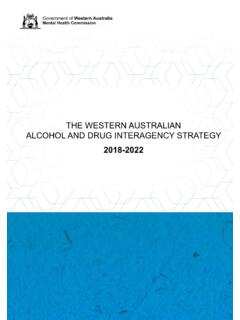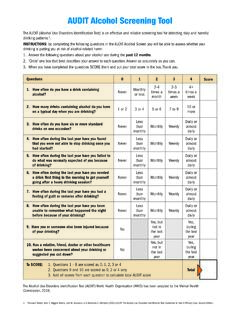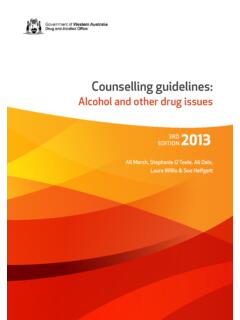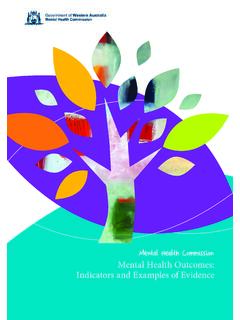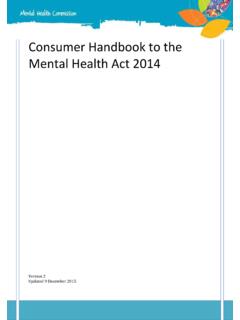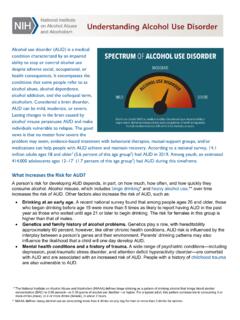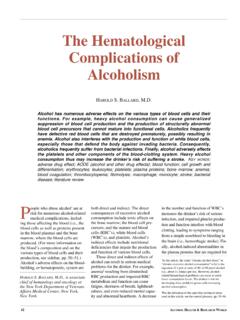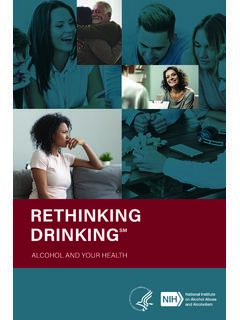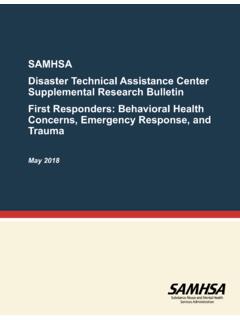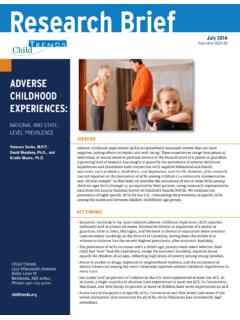Transcription of A brief guide to the Assessment and Treatment of Alcohol ...
1 A brief guide to theAssessment and Treatment of Alcohol DependenceiiA brief guide to the Assessment and Treatment of Alcohol DependenceSuggested citation: Quigley, A., Connolly, C., Palmer, B., & Helfgott, S. (2015) A brief guide to the Assessment and Treatment of Alcohol dependence (2nd ed.). Perth, Western Australia: Drug and Alcohol Office. ISBN: 978 -1- 876 6 8 4 - 6 3 -1 Western Australian Drug and Alcohol Authority 2015 Note The Drug and Alcohol Office is the business name of the Western Australian Alcohol and Drug Authority, which is an independent statutory authority established in November 1974. Its functions are set out in the Alcohol and Drug Authority Act booklet is produced by Next Step Drug and Alcohol Services and Workforce Development Branch, Drug and Alcohol Office. It may be reproduced in whole or in part for study or training purposes subject to an inclusion of an acknowledgement of the source and no commercial usage or sale.
2 Reproduction for purposes other than those above requires the written permission of: Drug and Alcohol Office, PO Box 126, Mount Lawley WA 6929 Website: AND ALCOHOLSERVICESNextStep1A brief guide to the Assessment and Treatment of Alcohol DependenceIntroduction ..2 Assessment ..2 History ..2 Mental state Assessment for the Alcohol dependent patient ..3 Physical examination ..3 Blood tests ..4 Other tests for health evaluation ..4 Screening and monitoring ..4 Treating Alcohol dependence and withdrawal ..5 Managing Alcohol withdrawal ..7 Medical management of Alcohol withdrawal ..8 Thiamine and Wernicke Korsakoff Syndrome ..9 Relapse prevention pharmacotherapies ..9 Future potential relapse prevention pharmacotherapies ..10 Counselling ..11 Psychology ..11 Neuropsychology ..11 Useful resource .. 1 MMSE Cognitive examination ..14 Appendix 2 Next Step version of the Revised Clinical Institute Withdrawal Assessment for Alcohol Scale (CIWA-Ar) (Reoux & Miller, 2000).
3 17 Contents2A brief guide to the Assessment and Treatment of Alcohol dependence features of dependence (See DSM-V page 5) morning withdrawal symptoms health complications from drinking other consequences from drinking history of other drug use recent use of other drugs current situation: accommodation, relationships, children, social support, work/study, legal issues, other agencies involved in care developmental history: family of origin, family relationships, childhood, education and work history, relationship history, abuse and other trauma history current and past mental health problems, diagnoses and Treatment risk Assessment : suicide, self harm, aggression and violence current physical well being and symptoms of illness past medical and surgical history past concussions or head injuries past withdrawal seizures or epilepsy current medication GuideNumber of Standard drinks1 can/stubby of full strength beer can/stubby of mid strength beer slab of full strength beer341 glass of wine bottle of wine 750ml7.
4 51 cask of wine 4L391 bottle of spirits 700ml22 Adapted from the National Health and Medical Research Council (NHMRC) Australian Alcohol Guidelines Alc Vol1375mlMid Alc Vol3424 x 375mlFull Alc Vol1100ml Standard Serve of White Alc Bottle of White Alc Vol394 Litres Cask White Alc Vol22700ml Bottle of Spirits40% Alc VolIntroductionThese clinical guidelines have been developed for use by doctors and nurses when assessing and treating a patient with Alcohol dependence . They will also be of interest to counsellors seeking detailed information about the medical Treatment of Alcohol comprehensive Assessment of a patient with Alcohol dependence will enable a case summary and formulation to be developed, a diagnosis to be made and an appropriate Treatment plan to be implemented. The Assessment should include a history, systemic enquiry, mental state examination, physical examination and blood comprehensive Alcohol and other drug history can take some time to obtain and may require a number of appointments, especially if the reasons for a person s drinking are to be explored.
5 The history should enable a calculation to be made of the number of standard drinks being consumed on the average drinking day. It should also include information about any withdrawal symptoms experienced and any physical or mental health complications from Alcohol use. A full history should cover the following: presenting problems and reasons for seeking Treatment Treatment goals and motivation to change past Alcohol and other drug Treatment history drinking history timeline: age started drinking, first problems, first dependent amount drunk in standard drinks in the last 24 hours and over the last week drinking pattern (type of drink, quantity, frequency) over last month and last year3A brief guide to the Assessment and Treatment of Alcohol DependenceMental state Assessment for the Alcohol dependent patientWhen assessing mental state, the clinician observes how the patient presents and functions during the session and briefly documents these observations.
6 Listed below are the areas covered in a mental state examination and some of the possible findings in Alcohol dependent patients. Some of these signs and symptoms may also be related to underlying physical and mental health conditions, therefore it is important to undertake a thorough Appearance and behaviour flushed face, smells of Alcohol , poor hygiene, unkempt clothing hostile, aggressive, sexualised behaviour (intoxication) fearful, paranoid (withdrawal) restless, tremors, agitation (withdrawal) ataxia (intoxication, Wernicke s encephalopathy)2. Speech slurred (intoxication)3. Mood and affect euphoric, depressed, irritable (intoxication) anxious, irritable, suspicious (withdrawal) labile (intoxication or withdrawal)4. Form of thought tangential, circumstantial, illogical (intoxication or delirium tremens (DTs)5. Content of thought confabulation (Korsakoff s syndrome)6. Perception hallucinations (DTs)7.)
7 Cognition (see Mini Mental State Examination Appendix 1) clouding of consciousness (intoxication, DTs, Wernicke s, hepatic encephalopathy) disoriented to time, place or person (intoxication, DTs, Wernicke s or Korsakoff s) poor planning and abstract thinking (brain damage) impaired short-term memory (Korsakoff s)8. Insight poor insight (intoxication, brain damage)Physical examinationPatients presenting with Alcohol dependence should have a comprehensive physical examination looking for evidence of intoxication or withdrawal, the stigmata of Alcohol dependence and signs of the medical complications of acute or chronic Alcohol a breathalyser is available, a blood Alcohol level is recommended prior to a physical examination, as it will set a base line for the physical examination. withdrawal signs may not be present because of a high blood Alcohol level and intoxication may not be present because of a high level of neuroadaptation.
8 Alcoholic facies conjunctival injection facial telangiectasia rhinophyma Evidence of injury Anaemia and bruising Neurological examination nystagmus ophthalmoplegia with 3rd and 6th nerve palsy impaired coordination truncal ataxia/gait abnormalities peripheral neuropathy/proximal muscle wasting Cardiac enlargement and oedema Abdominal examination hepatomegaly Evidence for cirrhosis and portal hypertension palmar erythema Dupuytren s contracture spider naevi parotid enlargement gynaecomastia splenomegaly ascites asterixis4A brief guide to the Assessment and Treatment of Alcohol DependenceOther tests for health evaluationOther blood tests should be ordered depending upon clinical findings and history. Two that are more commonly ordered in Alcohol dependence are:Coagulation profileLong-term Alcohol dependence and resulting advanced liver disease can significantly impair blood coagulation.
9 A coagulation profile should be ordered if there are signs of advanced liver disease on physical glucoseUsed if the patient has a history of pancreatitis which can affect insulin secretion and cause blood glucose levels to rise (hyperglycaemia). Alcohol impairs gluconeogenesis and may lead to hypoglycaemia, especially in the setting of starvation or glood glucose-lowering (diabetic) and monitoringA number of tests can be useful alone or in combination for screening and monitoring a patient s progress. They include raised: erythrocyte mean cell volume (MCV) gamma-glutamyltransferase (GGT) (not as sensitive or specific as CDT) carbohydrate deficient transferrin (CDT) (sensitivity 82% specificity 97% for >50gm per day of Alcohol ).Blood testsBlood tests for markers that are likely to change in the context of heavy drinking can be useful in assessing and treating Alcohol dependence for several reasons: they can be used to corroborate patient provided information they can provide feedback regarding Alcohol related organ damage to the patient which can assist motivation for change they can provide useful information as Treatment blood tests include full blood count, urea and electrolytes and liver function blood countUsed to screen for low haemoglobin.
10 This may be due to gastro-intestinal blood loss as a result of Alcohol induced gastritis/ulceration or nutritional neglect. There may also be red blood cell macrocytosis and a low platelet count from heavy regular Alcohol and electrolytesUsed to check the level of important electrolytes and renal function. Low potassium as a result of nutritional neglect or diarrhoea/vomiting is common and can require Treatment to reverse. Low sodium is less common but can occur due to high fluid intake. Low magnesium is a common finding in Alcohol function testsThe most commonly used liver function tests are: gamma-glutamyltransferase (GGT) aspartate-aminotranferase (AST) alanine-aminotransferase (ALT) albumin AST/ALT ratio >1 and significantly raised GGT are suggestive of Alcohol -related liver damage. Elevated bilirubin and liver enzymes suggest acute alcoholic hepatitis. Low albumin may result from reduced liver production in the context of more severe and longer term liver brief guide to the Assessment and Treatment of Alcohol DependenceTreating Alcohol dependence and withdrawalAlcohol dependenceAccording to the DSM-5 (American Psychiatric Association, 2013) a diagnosis of Alcohol use disorder (previously described as dependence ) can be made when a patient meets 2 or more of the following criteria within a 12 month period:1.
